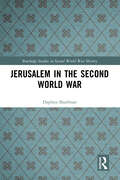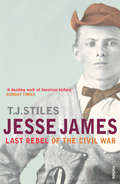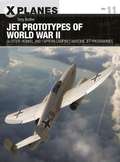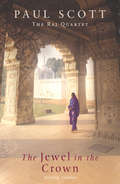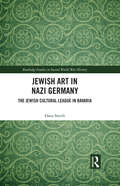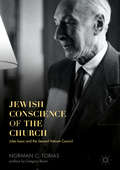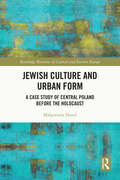- Table View
- List View
Jerusalem Falls: Seven Centuries of War and Peace
by John D. HoslerThe first full account of the medieval struggle for Jerusalem, from the seventh to the thirteenth century The history of Jerusalem is one of conflict, faith, and empire. Few cities have been attacked as often and as savagely. This was no less true in the Middle Ages. From the Persian sack in 614 through the bloody First Crusade and beyond, Jerusalem changed hands countless times. But despite these horrific acts of violence, its story during this period is also one of interfaith tolerance and accord. In this gripping history, John D. Hosler explores the great clashes and delicate settlements of medieval Jerusalem. He examines the city’s many sieges and considers the experiences of its inhabitants of all faiths. The city’s conquerors consistently acknowledged and reinforced the rights of those religious minorities over which they ruled. Deeply researched, this account reveals the way in which Jerusalem’s past has been constructed on partial histories—and urges us to reckon with the city’s broader historical contours.
Jerusalem in the Second World War (Routledge Studies in Second World War History)
by Daphna SharfmanThis book is the first to present the unique story of the city of Jerusalem during the events of the Second World War and how it played a unique role in both the military and civilian aspects of the war. Whilst Jerusalem is usually known for topics such as religion, archaeology, or the politics of the Israeli–Arab conflict, this volume provides an in-depth analysis of this exceptional and temporary situation in Jerusalem, offering a perspective that is different from the usual political-strategic-military analysis. Although battles were raging in the nearby countries of Syria and Lebanon, and the war in Egypt and the Western Desert, the people who came to Jerusalem, as well as those who lived there, had different agendas and perspectives. Some were spies and intelligence officers, other were exiles or refugee immigrants from Europe who managed at the last moment to escape Nazi persecution. Journalists and writers described life in the city at this time. All were probably conscious of the fact that when the war came to an end, local rivalry and mounting conflict would take the centre stage again. This was a time of a special, magical drawn-out moment that may shed light on an alternative, more peaceful, kind of Jerusalem that unfortunately was not to be. This volume seeks to find an alternative approach and to contribute to the development of insightful research into life in an unordinary city in an unordinary situation. It will be of value to those interested in military history and the history of the Middle East.
Jerusalem in the Second World War (Routledge Studies in Second World War History)
by Daphna SharfmanThis book is the first to present the unique story of the city of Jerusalem during the events of the Second World War and how it played a unique role in both the military and civilian aspects of the war. Whilst Jerusalem is usually known for topics such as religion, archaeology, or the politics of the Israeli–Arab conflict, this volume provides an in-depth analysis of this exceptional and temporary situation in Jerusalem, offering a perspective that is different from the usual political-strategic-military analysis. Although battles were raging in the nearby countries of Syria and Lebanon, and the war in Egypt and the Western Desert, the people who came to Jerusalem, as well as those who lived there, had different agendas and perspectives. Some were spies and intelligence officers, other were exiles or refugee immigrants from Europe who managed at the last moment to escape Nazi persecution. Journalists and writers described life in the city at this time. All were probably conscious of the fact that when the war came to an end, local rivalry and mounting conflict would take the centre stage again. This was a time of a special, magical drawn-out moment that may shed light on an alternative, more peaceful, kind of Jerusalem that unfortunately was not to be. This volume seeks to find an alternative approach and to contribute to the development of insightful research into life in an unordinary city in an unordinary situation. It will be of value to those interested in military history and the history of the Middle East.
Jerusalem in World War I: The Palestine Diary of a European Diplomat
by Conde de BallobarAfter the British occupation of Jerusalem in December 1917, the newly appointed governor Ronald Storrs met with the Spanish consul Conde de Ballobar. Over a glass of wine, the two men discussed politics and the future of Palestine. Storrs later reported in his extremely popular memoir, that Ballobar wrote a diary which according to him was not going to be published in his lifetime. It took several decades before the diary was in fact published in 1996 in Spanish. In this book, Roberto Mazza introduces the reader to the diary of Ballobar, available in English here for the first time, and provides a comprehensive historical background for readers in search of a fresh perspective on late Ottoman Jerusalem. In the autumn of 1914, Antonio de la Cierva y Lewita, better known as Conde de Ballobar, was sent to Jerusalem to take charge of the Spanish consulate in the city. He found himself at the centre of the socio-political life in Jerusalem and began to record events, experiences and opinions in a diary that has become an invaluable resource. The diary provides unique insight into late Ottoman Jerusalem - and the upheavals of wartime life in the city - and includes a detailed account of the battle amongst the local churches over control of the city's holy places. Also touching upon the development of Zionism and the establishment of British rule, Ballobar writes as a privileged observer of an exceptionally complex historical period.Jerusalem in World War I offers a precious record of events and insights on episodes and people often neglected due to a lack of original source material. Ballobar presents a vivid picture of a lively and dynamic city, making it unavoidable to draw parallels with the contemporary conflict and divisions. This book will be essential reading for students and scholars of the late-Ottoman Empire and World War I in the Middle East.
Jesse James: Last Rebel Of The Civil War
by T J StilesAt sixteen, Jesse James began his fighting career by killing Unionist neighbours on their doorsteps. In the bloodshed and bitterness that followed the South's surrender at Appomattox, Jesse and his fellow guerillas, with their gunfights and hold-ups, became part of the intensely brutal struggle by the White South against the racial egalitarianism and Federal power fostered by Reconstruction.In the first serious biography of Jesse James in forty years, T. J. Stiles paints a strikingly new and vivid portrait of the period before the American Civil War, during the conflict and its aftermath. With groundbreaking scholarship and dazzling reinterpretation, T. J. Stiles has refashioned one of the great legends of American history.
Jet Man: The Making and Breaking of Frank Whittle, Genius of the Jet Revolution
by Duncan Campbell-SmithThe story of Frank Whittle – RAF pilot, mathematician of genius, inventor of the jet engine and British hero. 'Wonderful' David Edgerton, TLS 'A fascinating account' Aeroplane Monthly 'Casts new light on the intense, heroic character of Frank Whittle' Leo McKinstry '[A] thorough dissection of the evolution of the jet engine... I recommend this mighty tome unreservedly' Journal of Aeronautical History 'A long overdue corrective of an extraordinary man' James Hamilton-Paterson 'A fine, deeply researched book' Military History MonthlyIn 1938, a thirty-one-year-old RAF pilot and engineer named Frank Whittle – given special leave to pursue his own startlingly original concept of flight – presented the Air Ministry with a written proposal for a revolutionary jet-powered fighter aircraft. A ready response might have changed the course of history, but Whittle got no reply.In this gripping and insightful biography, Duncan Campbell-Smith charts Whittle's success at building a pre-war jet engine against all the odds – and tracks his desperate struggle to have it launched into active service against Hitler's Luftwaffe. It arrived too late – but nonetheless transformed the future of aviation.
Jet Prototypes of World War II: Gloster, Heinkel, and Caproni Campini's wartime jet programmes (X-Planes)
by Tony ButtlerWhile World War II raged, pioneering aircraft and engine designers were busy developing the world's first practical jet-powered research aircraft to test and prove the new technology. This book examines the aircraft that paved the way for Germany's Me 262 and Britain's Meteor - the world's first jet fighters. Throughout the war, Germany, Italy and Britain engaged in top-secret jet programmes as they raced to develop the airpower of the future. Various experimental aircraft were trialled in order to achieve the goal of producing an effective engine and fighter that could harness the potential of the jet power. These included the German Heinkel He 178 research aircraft and Heinkel He 280 jet fighter prototype, the famed British E.28/39 research aircraft built by Gloster Aircraft as well as the stillborn E.5/42 fighter and E.1/44 Ace fighter prototype, and finally the remarkable Italian Caproni-Campini N.1/CC 2 research aircraft.Illustrated throughout with full-colour artwork and rare photographs, this fascinating study examines the fore-runners to the military jet age.
Jet Prototypes of World War II: Gloster, Heinkel, and Caproni Campini's wartime jet programmes (X-Planes #11)
by Tony ButtlerWhile World War II raged, pioneering aircraft and engine designers were busy developing the world's first practical jet-powered research aircraft to test and prove the new technology. This book examines the aircraft that paved the way for Germany's Me 262 and Britain's Meteor - the world's first jet fighters. Throughout the war, Germany, Italy and Britain engaged in top-secret jet programmes as they raced to develop the airpower of the future. Various experimental aircraft were trialled in order to achieve the goal of producing an effective engine and fighter that could harness the potential of the jet power. These included the German Heinkel He 178 research aircraft and Heinkel He 280 jet fighter prototype, the famed British E.28/39 research aircraft built by Gloster Aircraft as well as the stillborn E.5/42 fighter and E.1/44 Ace fighter prototype, and finally the remarkable Italian Caproni-Campini N.1/CC 2 research aircraft.Illustrated throughout with full-colour artwork and rare photographs, this fascinating study examines the fore-runners to the military jet age.
The Jet Race and the Second World War (Praeger Security International)
by S. Mike PavelecIn the 1930s, as nations braced for war, the German military build up caught Britain and the United States off-guard, particularly in aviation technology. The unending quest for speed resulted in the need for radical alternatives to piston engines. In Germany, Dr. Hans von Ohain was the first to complete a flight-worthy turbojet engine for aircraft. It was installed in a Heinkel-designed aircraft, and the Germans began the jet age on August 27, 1939. The Germans led the jet race throughout the war and were the first to produce jet aircraft for combat operations. In England, the doggedly determined Frank Whittle also developed a turbojet engine, but without the support enjoyed by his German counterpart. The British came second in the jet race when Whittle's engine powered the Gloster Pioneer on May 15, 1941. The Whittle-Gloster relationship continued and produced the only Allied combat jet aircraft during the war, the Meteor, which was relegated to Home Defense in Britain.In America, General Electric copied the Whittle designs, and Bell Aircraft contracted to build the first American jet plane. On October 1, 1942, a lackluster performance from the Bell Airacomet, ushered in the American jet age. The Yanks forged ahead, and had numerous engine and airframe programs in development by the end of the war. But, the Germans did it right and did it first, while the Allies lagged throughout the war, only rising to technological prominence on the ashes of the German defeat. Pavelec's analysis of the jet race uncovers all the excitement in the high-stakes race to develop effective jet engines for warfare and transport.
Jet the Rescue Dog: ... and other extraordinary stories of animals in wartime
by David LongAs mascots, messengers, rat-catchers and even spies, animals have long marched into war alongside servicemen and women. Dogs, horses, cats (even birds, camels and elephants) have saved thousands of lives through instinct, intelligence, courage and devotion. Like Jet, a dog who searched through ruins during the Blitz bombings to find survivors, or Sergeant Stubby, a dog who caught a spy. Or the pigeons who braved hurricanes, hawks and even snipers to help during WWII ... Engaging, uplifting and deeply moving, Jet the Rescue Dog tells the stories of these brave, silent heroes with sensitivity and gentle humour for readers age 8+. With black and white illustrations throughout.
Jet Turbine engine cross section (UEB Contracted)
In these diagrams of a jet engine, there is a cross section view through the length of the engine at the top of the page and in the bottom right of the page, a front view of the engine intake. There is a locator dot shown, which will be at the top left of the page when the image is the right way up. On the left of the page air is forced into the engine by the compressor which has many fan blades. The compressed air is fed into the combustion chamber in the middle of the page. Fuel is injected into the engine through a port in the lower centre part of the combustion chamber. This is where combustion and gas expansion takes place. On the right of the page the exhaust exits past the turbine producing the thrust of the engine. The front view shows the circular opening of the engine with lots of fan blades arranged around the central hub like a huge fan.
Jet Turbine engine cross section (UEB Uncontracted)
In these diagrams of a jet engine, there is a cross section view through the length of the engine at the top of the page and in the bottom right of the page, a front view of the engine intake. There is a locator dot shown, which will be at the top left of the page when the image is the right way up. On the left of the page air is forced into the engine by the compressor which has many fan blades. The compressed air is fed into the combustion chamber in the middle of the page. Fuel is injected into the engine through a port in the lower centre part of the combustion chamber. This is where combustion and gas expansion takes place. On the right of the page the exhaust exits past the turbine producing the thrust of the engine. The front view shows the circular opening of the engine with lots of fan blades arranged around the central hub like a huge fan.
The Jewel In The Crown (The\raj Quartet #No. 1)
by Paul ScottBOOK ONE OF THE RAJ QUARTETIndia 1942: everything is in flux. World War II has shown that the British are not invincible and the self-rule lobby is gaining many supporters. Against this background, Daphne Manners, a young English girl, is brutally raped in the Bibighat Gardens. The racism, brutality and hatred launched upon the head of her young Indian lover echo the dreadful violence perpetrated on Daphne and reveal the desperate state of Anglo-Indian relations. The rift that will eventually prise India - the jewel in the Imperial Crown - from colonial rule is beginning to gape wide.
Jewish Antifascism and the False Promise of Settler Colonialism
by Max KaiserThis book takes a timely look at histories of radical Jewish movements, their modes of Holocaust memorialisation, and their relationships with broader anti-colonial and anti-racist struggles. Its primary focus is Australia, where Jewish antifascism was a major political and cultural force in Jewish communities in the 1940s and early 1950s. This cultural and intellectual history of Jewish antifascism utilises a transnational lens to provide an exploration of a Jewish antifascist ideology that took hold in the middle of the twentieth century across Jewish communities worldwide. It argues that Jewish antifascism offered an alternate path for Jewish politics that was foreclosed by mutually reinforcing ideologies of settler colonialism, both in Palestine and Australia.
Jewish Art in Nazi Germany: The Jewish Cultural League in Bavaria (Routledge Studies in Second World War History)
by Dana SmithThis book provides a social and cultural history of Jewish art in Nazi Germany, with a focus on the Jewish artists, art critics, and audiences in Nazi Bavaria. From the time of its conceptualization in the autumn of 1933 until its final curtain call in November 1938, the Jewish Cultural League in Bavaria sustained three departments: music, visual arts, and adult education. The Bavarian example steps outside the highly professional cultural milieu of Jewish Berlin, and instead looks at relatively unknown efforts of Bavarian Jewish artists as they used art to define what it now meant, to them, to be Jewish under Nazism. Insightful and engaging, this book is ideal for advanced undergraduate students, graduate students, and scholars interested in social and cultural histories of Jews in Germany.
Jewish Art in Nazi Germany: The Jewish Cultural League in Bavaria (Routledge Studies in Second World War History)
by Dana SmithThis book provides a social and cultural history of Jewish art in Nazi Germany, with a focus on the Jewish artists, art critics, and audiences in Nazi Bavaria. From the time of its conceptualization in the autumn of 1933 until its final curtain call in November 1938, the Jewish Cultural League in Bavaria sustained three departments: music, visual arts, and adult education. The Bavarian example steps outside the highly professional cultural milieu of Jewish Berlin, and instead looks at relatively unknown efforts of Bavarian Jewish artists as they used art to define what it now meant, to them, to be Jewish under Nazism. Insightful and engaging, this book is ideal for advanced undergraduate students, graduate students, and scholars interested in social and cultural histories of Jews in Germany.
Jewish Child Soldiers in the Bloodlands of Europe (Routledge Studies in Second World War History)
by David M. RosenThis book is about the experiences of Jewish children who were members of armed partisan groups in Eastern Europe during World War II and the Holocaust. It describes and analyze the role of children as activists, agents, and decision makers in a situation of extraordinary danger and stress. The children in this book were hunted like prey and ran for their lives. They survived by fleeing into the forest and swamps of Eastern Europe and joining anti-German partisan groups. The vast majority of these children were teenagers between ages 11 and 18, although some were younger. They were, by any definition, child soldiers, and that is the reason they lived to tell their tales. The book will be of interest to general and academic audiences. There is also great interest in children and childhood across disciplines of history and the social sciences. It is likely to spark considerable debate and interest, since its argument runs counter to the generally accepted wisdom that child soldiers must first and foremost be seen as victims of their recruiters. The argument of this book is that time, place, and context play a key role in our understanding of children’s involvement in war and that in some contexts children under arms must be seen as exercising an inherent right of self-defense.
Jewish Child Soldiers in the Bloodlands of Europe (Routledge Studies in Second World War History)
by David M. RosenThis book is about the experiences of Jewish children who were members of armed partisan groups in Eastern Europe during World War II and the Holocaust. It describes and analyze the role of children as activists, agents, and decision makers in a situation of extraordinary danger and stress. The children in this book were hunted like prey and ran for their lives. They survived by fleeing into the forest and swamps of Eastern Europe and joining anti-German partisan groups. The vast majority of these children were teenagers between ages 11 and 18, although some were younger. They were, by any definition, child soldiers, and that is the reason they lived to tell their tales. The book will be of interest to general and academic audiences. There is also great interest in children and childhood across disciplines of history and the social sciences. It is likely to spark considerable debate and interest, since its argument runs counter to the generally accepted wisdom that child soldiers must first and foremost be seen as victims of their recruiters. The argument of this book is that time, place, and context play a key role in our understanding of children’s involvement in war and that in some contexts children under arms must be seen as exercising an inherent right of self-defense.
Jewish Conscience of the Church: Jules Isaac and the Second Vatican Council
by Norman C. TobiasThis book presents the backstory of how the Catholic Church came to clarify and embrace the role of Israel in salvation history, at the behest of an unlikely personality: Jules Isaac. This embrace put to an end the tradition, more than fifteen centuries old, of anti-Jewish rhetoric that had served as taproot to racial varieties of anti-Semitism. Prior to Isaac’s thought and activism, this contemptuous tradition had never been denounced in so compelling a manner that the Church was forced to address it. It is a story of loss and triumph, and ultimately, unlikely partnership. Isaac devoted his years after World War II to a crusade for scriptural truth and rectification of Christian teaching regarding Jews and Judaism. Isaac’s crusade culminated in an unpublicized audience with Pope John XXIII—a meeting that moved the pope to make a last-minute addition to the Second Vatican Council agenda and set in motion the events leading to a revolution in Catholic teaching about Jews.
Jewish Conscience of the Church: Jules Isaac and the Second Vatican Council
by Norman C. TobiasThis book presents the backstory of how the Catholic Church came to clarify and embrace the role of Israel in salvation history, at the behest of an unlikely personality: Jules Isaac. This embrace put to an end the tradition, more than fifteen centuries old, of anti-Jewish rhetoric that had served as taproot to racial varieties of anti-Semitism. Prior to Isaac’s thought and activism, this contemptuous tradition had never been denounced in so compelling a manner that the Church was forced to address it. It is a story of loss and triumph, and ultimately, unlikely partnership. Isaac devoted his years after World War II to a crusade for scriptural truth and rectification of Christian teaching regarding Jews and Judaism. Isaac’s crusade culminated in an unpublicized audience with Pope John XXIII—a meeting that moved the pope to make a last-minute addition to the Second Vatican Council agenda and set in motion the events leading to a revolution in Catholic teaching about Jews.
Jewish Culture and Urban Form: A Case Study of Central Poland before the Holocaust (Routledge Histories of Central and Eastern Europe)
by Małgorzata HanzlAcross a range of disciplines, urban morphology has offered lenses through which we can read the city. Reading the urban form, when conflated with ethnographic studies, enables us to return to past situations and recreate the long-gone everyday life. Urbanscapes – the artefacts of urban life – have left us the story portrayed in the pages of this book. The notions of time and space contribute to depicting the Jewish-Polish culture in central Poland before the Holocaust. The research proves that Jewish society in pre-Holocaust Poland was an example of self-organising complexity. Through bottom-up activities, it had a significant impact on the unique character of the spaces left behind. Several features confirm this influence. Not only do the edifices, both public and private, convey meanings related to the Jewish culture, but public and semi-private space also tell the story of long-gone social situations. The specific atmosphere that still lingers there recalls the long-gone Jewish culture, with the unique settlement patterns indicating a separate spatial order. The Author reveals to the international cast of practitioners and theorists of urban and Jewish studies a vivid and comprehensive account. This book will appeal to researchers and students alike studying Jewish communities in Poland and Jewish-Polish society and urbanisation, as well as all those interested in Jewish-Polish Culture.
Jewish Culture and Urban Form: A Case Study of Central Poland before the Holocaust (Routledge Histories of Central and Eastern Europe)
by Małgorzata HanzlAcross a range of disciplines, urban morphology has offered lenses through which we can read the city. Reading the urban form, when conflated with ethnographic studies, enables us to return to past situations and recreate the long-gone everyday life. Urbanscapes – the artefacts of urban life – have left us the story portrayed in the pages of this book. The notions of time and space contribute to depicting the Jewish-Polish culture in central Poland before the Holocaust. The research proves that Jewish society in pre-Holocaust Poland was an example of self-organising complexity. Through bottom-up activities, it had a significant impact on the unique character of the spaces left behind. Several features confirm this influence. Not only do the edifices, both public and private, convey meanings related to the Jewish culture, but public and semi-private space also tell the story of long-gone social situations. The specific atmosphere that still lingers there recalls the long-gone Jewish culture, with the unique settlement patterns indicating a separate spatial order. The Author reveals to the international cast of practitioners and theorists of urban and Jewish studies a vivid and comprehensive account. This book will appeal to researchers and students alike studying Jewish communities in Poland and Jewish-Polish society and urbanisation, as well as all those interested in Jewish-Polish Culture.
Jewish Exiles’ Psychological Interpretations of Nazism
by Avihu ZakaiThis book examines works of four German-Jewish scholars who, in their places of exile, sought to probe the pathology of the Nazi mind: Wilhelm Reich’s The Mass Psychology of Fascism (1933), Erich Fromm’s Escape from Freedom (1941), Siegfried Kracauer’s From Caligari to Hitler: A Psychological History of the German Film (1947), and Erich Neumann’s Depth Psychology and a New Ethic (1949). While scholars have examined these authors’ individual legacies, no comparative analysis of their shared concerns has yet been undertaken, nor have the content and form of their psychological inquiries into Nazism been seriously and systematically analyzed. Yet, the sense of urgency in their works calls for attention. They all took up their pens to counter Nazi barbarism, believing, like the English jurist and judge Sir William Blackstone, who wrote in 1753 - scribere est agere ("to write is to act").
The Jewish Experience of the First World War
by Edward Madigan Gideon ReuveniThis book explores the variety of social and political phenomena that combined to the make the First World War a key turning point in the Jewish experience of the twentieth century. Just decades after the experience of intense persecution and struggle for recognition that marked the end of the nineteenth century, Jewish men and women across the globe found themselves drawn into a conflict of unprecedented violence and destruction. The frenzied military, social, and cultural mobilisation of European societies between 1914 and 1918, along with the outbreak of revolution in Russia and the collapse of the Ottoman Empire in the Middle East had a profound impact on Jewish communities worldwide. The First World War thus constitutes a seminal but surprisingly under-researched moment in the evolution of modern Jewish history. The essays gathered together in this ground-breaking volume explore the ways in which Jewish communities across Europe and the wider world experienced, interpreted and remembered the ‘war to end all wars’.
Jewish Frontiers: Essays on Bodies, Histories, and Identities
by S. GilmanIn this collection of new essays, Sander Gilman muses on Jewish memory and representation throughout the twentieth-century. Bringing together the worlds of literature, medicine, and popular culture in his characteristic ways, Gilman looks at new, post-diasporic ways of understanding the limits of Jewish identity. Topics include the development of the genre of Holocaust comedy, the imagination of the relationship of the body, disease, and identity, and the place of Jews in today's multicultural society.

